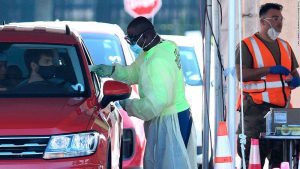OCTOBER 18, 2020

Health care workers perform COVID-19 testing at a drive-through site at Eastern Florida State College on October 9, 2020 in Palm Bay, Florida. The Florida Department of Health reports that COVID-19 cases, deaths, and hospitalizations are on the rise while U.S President Donald Trump plans to hold a rally in Sanford, Florida after contracting the disease. (Photo by Paul Hennessy/NurPhoto via AP)
There is nearly no place in America where Covid-19 case counts are trending in the right direction as the country heads into what health experts say will be the most challenging months of the pandemic.
The US is averaging more than 55,000 new cases a day — up more than 60% since a mid-September dip — and experts say the country is in the midst of the dreaded fall surge. On Friday, the US reported the most infections in a single day since July. As of Saturday, more than 8.1 million cases of the virus had been reported in the US and 219,286 people have died, according to Johns Hopkins University.
Only Missouri and Vermont recorded a more than 10% improvement in the average number of reported cases over the past week, according to the university’s data. Cases in Connecticut and Florida, on the other hand, increased by 50% or more.
Twenty-seven states saw spikes between 10% and 50%: Alabama, Arizona, Colorado, Georgia, Idaho, Illinois, Indiana, Iowa, Kansas, Massachusetts, Michigan, Minnesota, Mississippi, Nebraska, Nevada, New Jersey, New Mexico, North Dakota, Ohio, Rhode Island, South Carolina, South Dakota, Texas, Washington, West Virginia, Wisconsin and Wyoming.
New cases are static in the remaining states.
“This really is a harrowing time, and people have to be careful,” epidemiologist Dr. Abdul El-Sayed said.
‘This surge has the potential to be way worse’
On Friday, 10 states reported their highest one-day counts: Colorado, Idaho, Indiana, Minnesota, New Mexico, North Carolina, North Dakota, West Virginia, Wisconsin and Wyoming, according to Johns Hopkins.
As infections rise, so, too, have hospitalizations. In New Mexico, hospitalizations have increased 101% this month, Gov. Michelle Lujan Grisham said.
More hospitalizations will likely be followed by a rise in daily coronavirus deaths, said Dr. Francis Collins, director of the National Institutes of Health.
Though the average of 700 coronavirus deaths a day the US remains lower than the daily tolls of 1,000 in July and August, University of Washington researchers project more than 2,300 Americans could die daily by mid-January.
“When we saw this kind of transmission earlier on in the pandemic, in March and April, the virus hadn’t seeded everywhere. … This surge has the potential to be way worse than it was than either the spring or the summer,” El-Sayed, Detroit’s former health director, said.
State leaders push new restrictions
Americans can help get the virus under control, experts say, by heeding guidelines touted by officials for months: avoiding crowded settings, keeping a distance, keeping small gatherings outdoors and wearing a mask.
“This is a good moment for people to stop and ask themselves: ‘What can I do to try to be sure that we limit the further infections that otherwise seem to be looming in front of us as cold weather is kicking in and people are indoors, and those curves are going upward, in the wrong direction?'” Collins said Friday.
The upticks have prompted state leaders to push new restrictions, including mask enforcement and limits on gatherings, in hopes of curbing the spread.
Nebraska Gov. Pete Ricketts announced changes to the state’s health measures, including requiring hospitals to reserve at least 10% of staffed general and ICU beds for Covid-19 patients.
In Kentucky, Gov. Andy Beshear said this month he instructed authorities to step up mask enforcement, and in New Mexico, the governor this week ordered new mass gathering limitations and a 10 p.m. closing time for establishments serving alcohol.
“Every New Mexican can and must do their part to stop the spread of COVID-19 by staying home, limiting their interactions with others, and wearing their masks,” Grisham tweeted.
Courtesy/Source: CNN










































































































